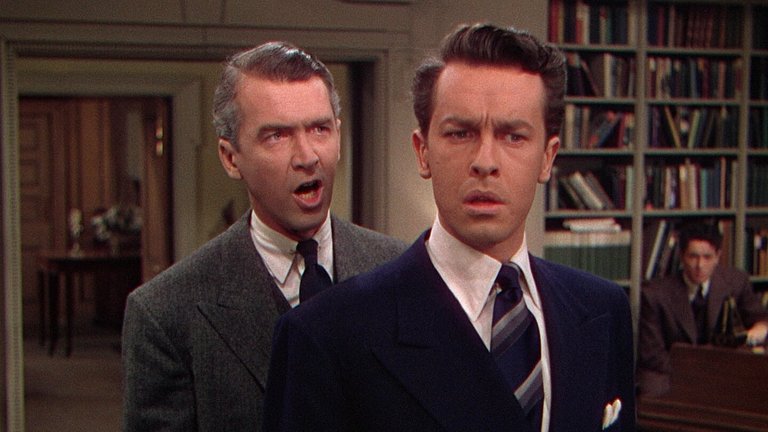Film Review: Rope (1948)

In the long history of Hollywood there were some rare instances when major studios indulged in producing films that can be described as experimental. Same can be said of filmography of Alfred Hitchcock, whose 1948 psychological thriller Rope is considered to be the most experimental of all his films.
The film is based on the eponymous 1929 stage play British author Patrick Hamilton, which was inspired by infamous real life case of Leopold and Loeb. The plot is set in New York penthouse apartment and begins with young man named David Kentley (played by Dick Hogan) being strangled to death by his two former prep school mates Brandon Shaw (played by John Dall ) and Philip Morgan (played by Fairley Granger). The only motive for the crime is killers’ desire to comitt perfect murder and Brandon, who owns the apartment, further tests whether he would get away with it by throwing a party attended by David’s father Henry (played by Cedric Hardwicke), his aunt Anita Atwater (played by Constance Collier), David’s girlfriend Janet Walker (played by Joan Chandler), her former boyfriend Kenneth Lawrence (played by Douglas Dick) and their former prep school teacher Rupert Caddell (played by James Stewart) who now works as a publisher. Brandon and Philip have hidden David’s body in antique wooden chest which Brandon would deliberately use as buffet table for his guests. This and Brandon’s increasingly unsubtle hints about David’s absence and his violent demise make Philip increasingly rattled, which is noticed by Rupert who begins to wonder whether there is some dark unpleasant secret his pupil might hide.
Rope is known as Hitchcock’s first film in colour, but most cinephiles know it for another novelty. Hitchcock has, apart from brief introductory scene, made entire film in what appears one long continuous shot. Hitchock achieved this through clever editing, extremely long takes and ingenious fixing on camera on dark spots that could allow quick and smooth transition, thus creating illusion of continuous take. This technique is not exactly uncommon and it was, among other directors, used by Alexander Sokurov in Russian Ark and, more recently, by Sam Mendes in 1917. Hitchcock apparently got the idea for film nearly a decade earlier in his native Britain, when he was watching previous screen adaptation of Hamilton’s work in the form of early television play aired on BBC. Such early television plays were never recorded and were aired live instead, so, without editing, directors had to rely on various ingenious ways to keep the plot or a scene within confines of a single long take. Hitchock employs same directing style here and it looks interesting, but only at the beginning. Soon the limitations of the concept become apparent, more notably with entire plot being set in a single apartment during very limited time. Rope looks not only very “gimmicky”, but Hitchock’s attempts to maintain suspense only result to make the film look much longer than its unusually short 80 minutes. Hitchcock somehow manages to fill the play with references that could delight cinephiles – like characters describing his previous film Notorious or mentioning actors that used to work or would later work for him.
References that caught attention in more recent times are more implicit and they deal with homosexuality, a content that was impossible to even mention and depict openly in Classic Hollywood films. Leopold and Loeb, real life killers inspiring the main characters, were gay. So was the scriptwriter Arthur Laurents who went on record on describing Brandon and Philip as lovers. John Dall, actor playing Brandon, was rumoured to be gay while Fairley Granger was later quite open about his bisexuality. But all that content, implicit or not, won’t help Rope with viewers who don’t have much interest in Hollywood history. Hitchcock did direct film with skill, but the background showing New York City skyline looks artificial and tells that the entire film was shot in studio. Acting is, on the other hand, very good, especially in case with Dall who is great as young psychopath, and Granger (who would later work with Hitchcock on Strangers on a Train) is very convincing as nervous wreck. But James Stewart appears disappointing, mainly because of the script that forces his initially enigmatic and cynical character to turn into sermon-giving moral crusader near the end. Stewart publicly expressed displeasure with his film and so did Hitchcock, who would later describe it as “failed experiment”. Yet, Rope shows that even mediocre Hitchcock is at time better than the best works of many celebrated film makers that arrived after him.
RATING: 6/10 (++)
_
Blog in Croatian https://draxblog.com
Blog in English https://draxreview.wordpress.com/
InLeo blog https://inleo.io/@drax.leo
InLeo: https://inleo.io/signup?referral=drax.leo
Unstoppable Domains: https://unstoppabledomains.com/?ref=3fc23fc42c1b417
Hiveonboard: https://hiveonboard.com?ref=drax y
Bitcoin Lightning HIVE donations: https://v4v.app/v1/lnurlp/qrcode/drax
Rising Star game: https://www.risingstargame.com?referrer=drax
1Inch: https://1inch.exchange/#/r/0x83823d8CCB74F828148258BB4457642124b1328e
BTC donations: 1EWxiMiP6iiG9rger3NuUSd6HByaxQWafG
ETH donations: 0xB305F144323b99e6f8b1d66f5D7DE78B498C32A7
Posted using CineTV
